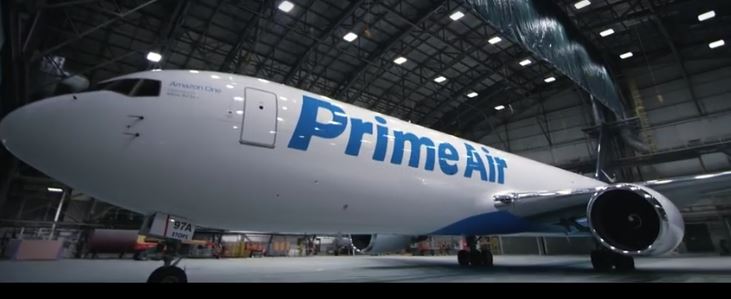Amazon’s sales in North America rose 28% over the year in Q2 2016 to reach nearly USD 18 billion. It has millions of customers as members of its annual USD 99 Prime membership- that allows exclusive access to delivery service, also dubbed Amazon Prime Air, and now it has unveiled Amazon One, the first aircraft in a set of Boeing 767-300, wide-body planes that will be part of its Prime Air fleet.
Prime Air Aims To Streamline Operations, Reduce Shipping Costs
Amazon currently has 10 planes in operation, but the new Amazon One will be the company’s first own aircraft (on lease, though), and will display the brand’s name in huge blue letters against a white background. It will be operated by Atlas Air, a U.S. airline that mostly flies cargo airplanes. The company eventually plans to have around 40 dedicated freighters operating between its warehouses and distribution centers over the next two years, under deals signed with two aircraft leasing companies — Atlas, and Air Transport Services Group in early 2016.
The video above shows the Amazon One get ready to the takeoff for the annual Seafair event in Seattle, Washington. You can see the company name on the plane’s belly and the smile logo on the tail section. The move is part of the broader vision of Amazon founder and CEO Jeff Bezos to build on Amazon’s ability to streamline delivery operations by creating a network of leasing trucks, cargo ships, unmanned drones and cargo freighters.
This will enable the company to bypass services like Fedex and UPS and curb rising package delivery costs. Amazon reportedly spent USD 3.36 billion on shipping alone in Q2, nearly 44% more than last year. Compared to that, total turnover grew only 31%.
According to Amazon’s Senior Vice President of Operations Dave Clark, the objective is to provide company sufficient shipping capacity for peak periods and flexibility for normal operations as its Prime business grows.

‘You can almost think about the difference between commercial flight and private flight. We have the ability, with our own planes, to create connections between one point and another point that are exactly tailored to our needs, and exactly tailored to the timing of when we want to put packages on those routes — versus other peoples’ networks which are optimized to run their entire network. We add capacity, we add flexibility, and it gives us cost-control capability as well,’ said Clark.
For instance, the flights will help in the east coast-west coast runs for specific specialized inventory and imports, added Clark.
Amazon Continues To Expand
It is imperative for a huge e-tailer like Amazon to continue innovating and come up with new ways to boost its logistics operations. The launch of its dedicated cargo planes is the latest step in expanding its global presence. The company has already grown its number of fulfillment and sorting centers to more than 145 across the globe, and is also working to set up its own local delivery service in certain markets.

The tech giant has a rosy outlook for the future, with its stock trading at a record high (owing to positive consumer sentiment on the investments into cloud computing, logistics third party merchants), increasing traction in segments such as retail and groceries, and rising e-commerce margins.
Analysts at Deutsche Bank expect the company to stay dominant in the coming quarters due to its logistics advantage and overall strategy. Business is booming and it will be exciting to see what all Amazon has in store for the future.













Leave a Reply